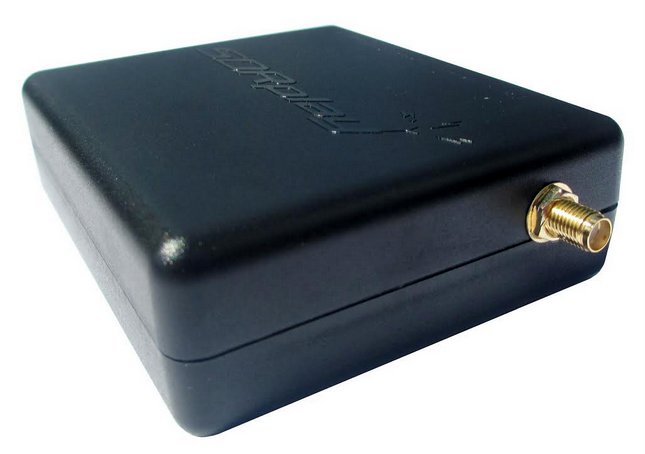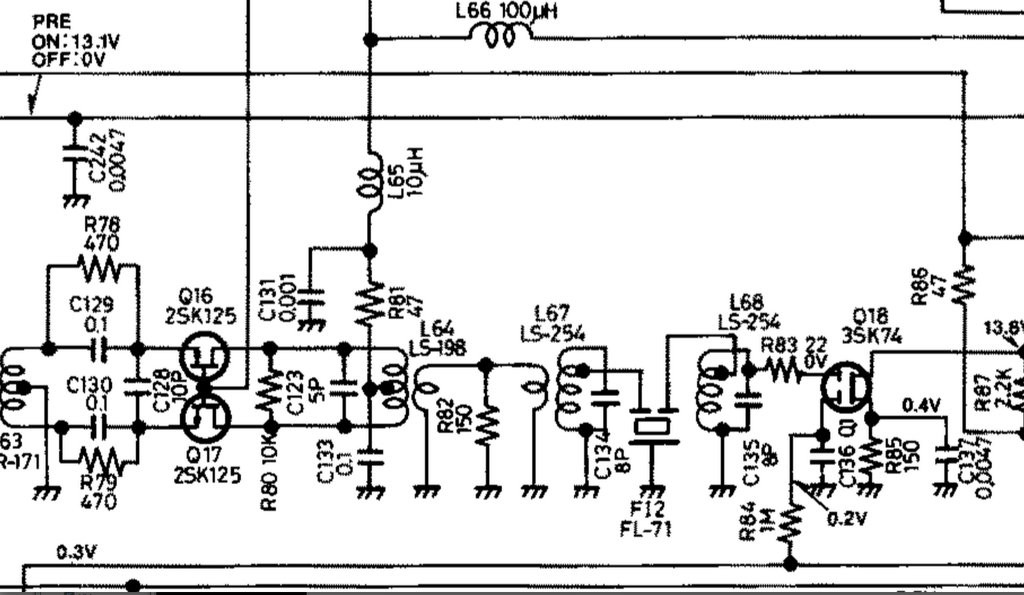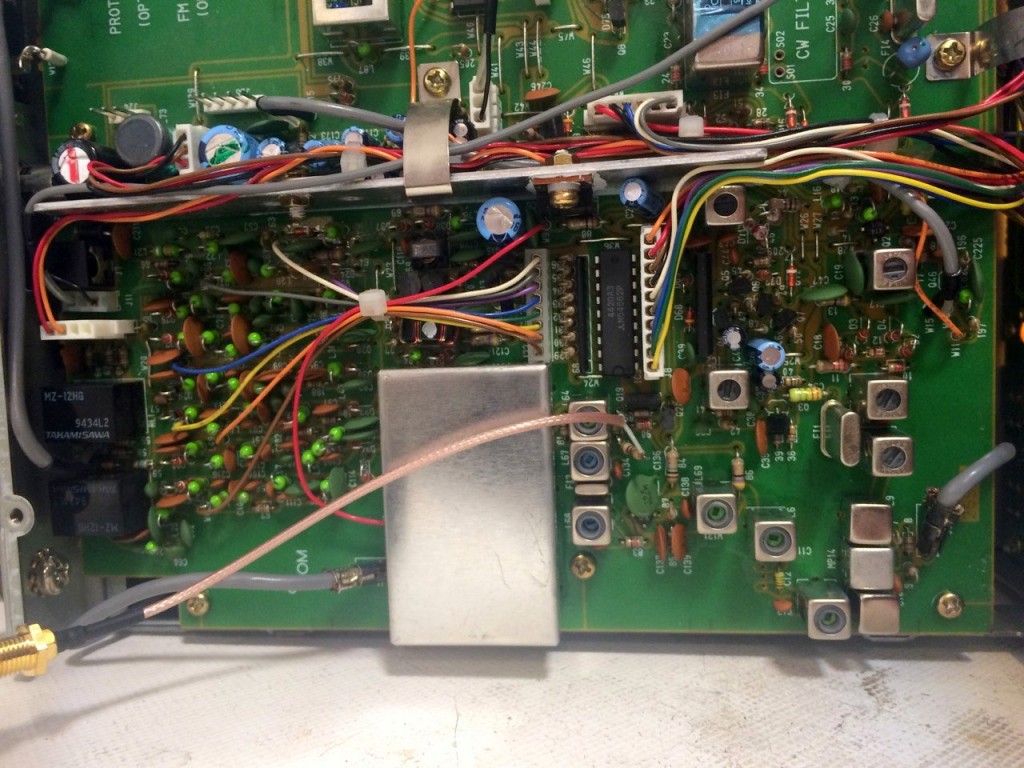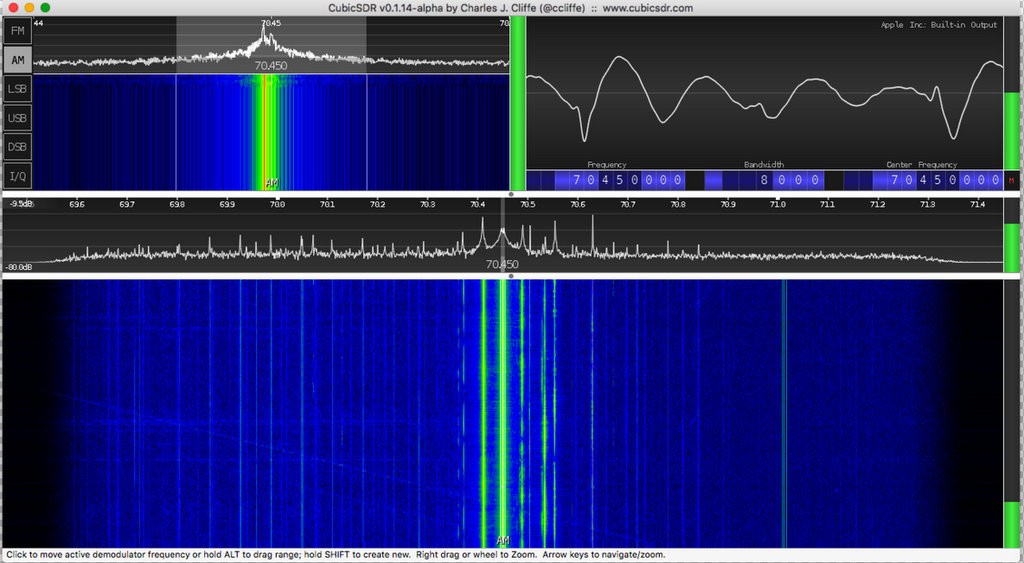
In this post, I will show you how to use an SDR as a panadapter for a commercial communications receiver. I’m using an Icom R72 and a SDRPlay RSP, but you can do it with nearly all receivers and SDRs.
The Icom R72 is a double conversion HF (0-30 MHz) communications receiver.
A panadapter lets you see the spectrum of your receiver (it gives you a broader, higher-level picture of what’s around your tuned frequency). After using it, you’ll wonder how you’ve been using your receiver without a spectrum display! 🙂
Almost all the radios we use are of superhetrodyne type. To connect a SDR to the radio, you should first find its 1st IF mixer output (if it has more than one Intermediate Frequency stage).
To find it, the best way is to consult the service manual. The first IF of Icom R72 is 70.4500 MHz, so we can use RTL-SDR dongles too.
Here’s a part of R72’s schematics, extracted from its service manual:

Look at the R82 resistor; it’s located at the output of first IF stage, so I soldered a connector to its pins (its other pin is connected to the ground)
Between the R82 resistor and the output, we’ve added a series 470-ohm resistor (to prevent loading the IF stage)

Click to enlarge.
The other side of this connector is connected to the antenna input of my SDRPlay RSP.
Now I can view my spectrum on a PC.
Here’s a screenshot of CubicSDR on Mac OS X (you can use other apps like HDSDR, SDR Console, etc.):

Although this post was about the SDRPlay RSP and Icom R72, this procedure can be done for almost any combination of receivers and SDRs provided that your SDR covers the frequency of first IF stage.
Also, don’t forget that you should tune the SDR to the frequency of IF–in this case: 70.4500 MHz.
Mehdi Asgari, the author of this post, is a regular contributor to the SWLing Post. Mehdi lives in Tehran and is an active member of the EP2C amateur radio club.

I don’t understand the reason to connect to the first IF. My best results are with the RTL-SDR dongle connected to a long wire.
Connecting to the first IF on my Kenwood TS-570D is easy enough, but not great reception. Am I missing the obvious??
73
Hello,
Is this wizardry possible on my icom ic-r8500?
could someone please point me in the right direction to try this.
very new to this world and in need of advice
regards
hal
uk
Hi Mehdi
very interesting and good article, thank you. I own an ICOM IC-736.
Am I right in the assumption that I have to connect the SDR to R67/82 Ohms?
(google “IC 736 service manual” for the IC-736 manual, see page 89 for the schematic, page 9 for the description of the schematics).
Thank you.
Markus
Did you ever figure out where to tap on the 736
Hi Justin
My idea was to connect the SDR to R67/82 Ohms. Up to now I haven’t tried this (lack of time and elaborate disassembly of the rig, there are a lot of small connectors)
I am also not sure if you can connect the SDR without a buffer amplifier?
Do you have experience in this matter?
73 de Markus
I have a buffer board. Yeah, the 7936 board is hard to ready. Most of the components don’t have any markings on the PCB.
Interesting, indeed. As a relatively new SDRPlay RSP owner, I too was thinking of observing and using the RSP’s open API language to “create” new uses for the unit, yet a panadapter idea means a lot less code work, and a bit more hardware and schematic observation.
Anyone game to try with me an SDRPlay RSP-based panadapter for the venerable Grundig Satellit 800 receivers ? On the Satellit 800, the IF frequencies are:
AM/SSB: 1st IF 55.845 MHz. 2nd IF 455 kHz. (Dual Conversion)
FM: First IF 10.7 MHz (Single Conversion).
Joe
Skype me at: joerotello
eMail: info at windowgroup dot com
Hi Joseph
What you want to know? The exact place of 1st IF to connect SDRPlay?
Mehdi
Being blessed with two Sat 800 units, one can be used for testing and “body research”, so I do have a handle on where to place the IF tap off one or two possible locations, in fact.
However, if you have had a chance to get into the Sat 800, any ideas or comments you have are always welcomed, consumed and considered by eager ears.
Joe
You definitely want it off the first IF, so the bandwidth is wide. Then you get to see up and down from where you’ve tuned.
Michael
You should connect your SDR to the VC601 (located at the output of T607)
I’ve highlighted it in this picture:
http://imgur.com/s6eVVBj
The Elad FDM-S2 software has a Pan Adapter mode that allows tuning the radio via the software. The receive frequencies are displayed across the spectrum display instead of the IF frequencies. The FDM-S2 is over three times more expensive than the SDRplay RSP. I have used it with a couple of radios with 10.7 MHz IF outputs.